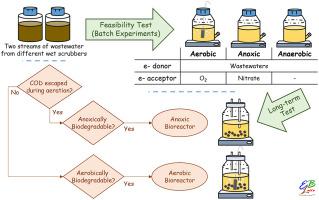Chemosphere ( IF 8.1 ) Pub Date : 2021-06-09 , DOI: 10.1016/j.chemosphere.2021.131137 Hai-Hsuan Cheng, I-Chun Lu, Po-Wei Huang, Yi-Ju Wu, Liang-Ming Whang

|
This study investigated biological treatment for two kinds of volatile organic compounds (VOCs)-containing wastewaters collected from wet scrubbers in a semiconductor industry. Batch test results indicated that one wastewater containing highly volatile organic compounds was not suitable for aerated treatment conditions while the other containing much lower volatile organic compounds was suitable for aerobic treatment. Accordingly, two moving bed bioreactors, by adding commercial biocarrier BioNET, were operated under aerobic and anoxic conditions for treating low volatility wastewater (LVW) and high volatility wastewater (HVW), respectively. During 280 days of operation, the aerobic LVW bioreactor attained the highest chemical oxygen demand (COD) removal rate of 98.9 mg-COD/L/h with 81% of COD removal efficiency at hydraulic retention time (HRT) of 1 day. The anoxic HVW bioreactor performed above 80% of COD removal efficiency with the highest COD removal rate of 16.5 mg-COD/L/h at HRT of 2 days after 380 days of operation. The specific COD removal rates at different initial substrate-to-biomass (S0/X0) ratios, using either suspended sludge or microorganisms attached onto BioNET from both bioreactors, followed the Monod-type kinetics, while the half-saturation coefficients were generally higher for the microorganisms onto BioNET due presumably to relatively poor mass transfer efficiency. Based on the results of microbial community analysis using the next generation sequencing technique, the dominant communities of suspended sludge and BioNET, including nitrifiers, denitrifiers, and degraders for polycyclic aromatic hydrocarbons, were similar in the corresponded bioreactors, but microbial community shifts were observed with increased organic loadings.
中文翻译:

半导体行业湿式洗涤塔含挥发性有机化合物(VOCs)废水的生物处理
本研究调查了从半导体行业的湿式洗涤器收集的两种含有挥发性有机化合物 (VOC) 的废水的生物处理。批量试验结果表明,一种含有高挥发性有机化合物的废水不适用于曝气处理条件,而另一种含有低得多的挥发性有机化合物的废水则适用于好氧处理。因此,通过添加商业生物载体 BioNET,两个移动床生物反应器在好氧和缺氧条件下运行,分别用于处理低挥发性废水 (LVW) 和高挥发性废水 (HVW)。在 280 天的运行期间,好氧 LVW 生物反应器达到了最高的化学需氧量 (COD) 去除率 98。9 mg-COD/L/h,在水力停留时间 (HRT) 为 1 天时,COD 去除效率为 81%。缺氧 HVW 生物反应器在运行 380 天后的 2 天 HRT 条件下,COD 去除率达到 80% 以上,最高 COD 去除率为 16.5 mg-COD/L/h。不同初始底物对生物量的特定 COD 去除率 (S0 /X 0 ) 比率,使用悬浮污泥或从两个生物反应器附着在 BioNET 上的微生物,遵循 Monod 型动力学,而 BioNET 上的微生物的半饱和系数通常较高,这可能是由于传质效率相对较差。基于使用下一代测序技术的微生物群落分析结果,悬浮污泥和 BioNET 的优势群落,包括硝化剂、反硝化剂和多环芳烃降解剂,在相应的生物反应器中相似,但观察到微生物群落变化增加有机负荷。











































 京公网安备 11010802027423号
京公网安备 11010802027423号